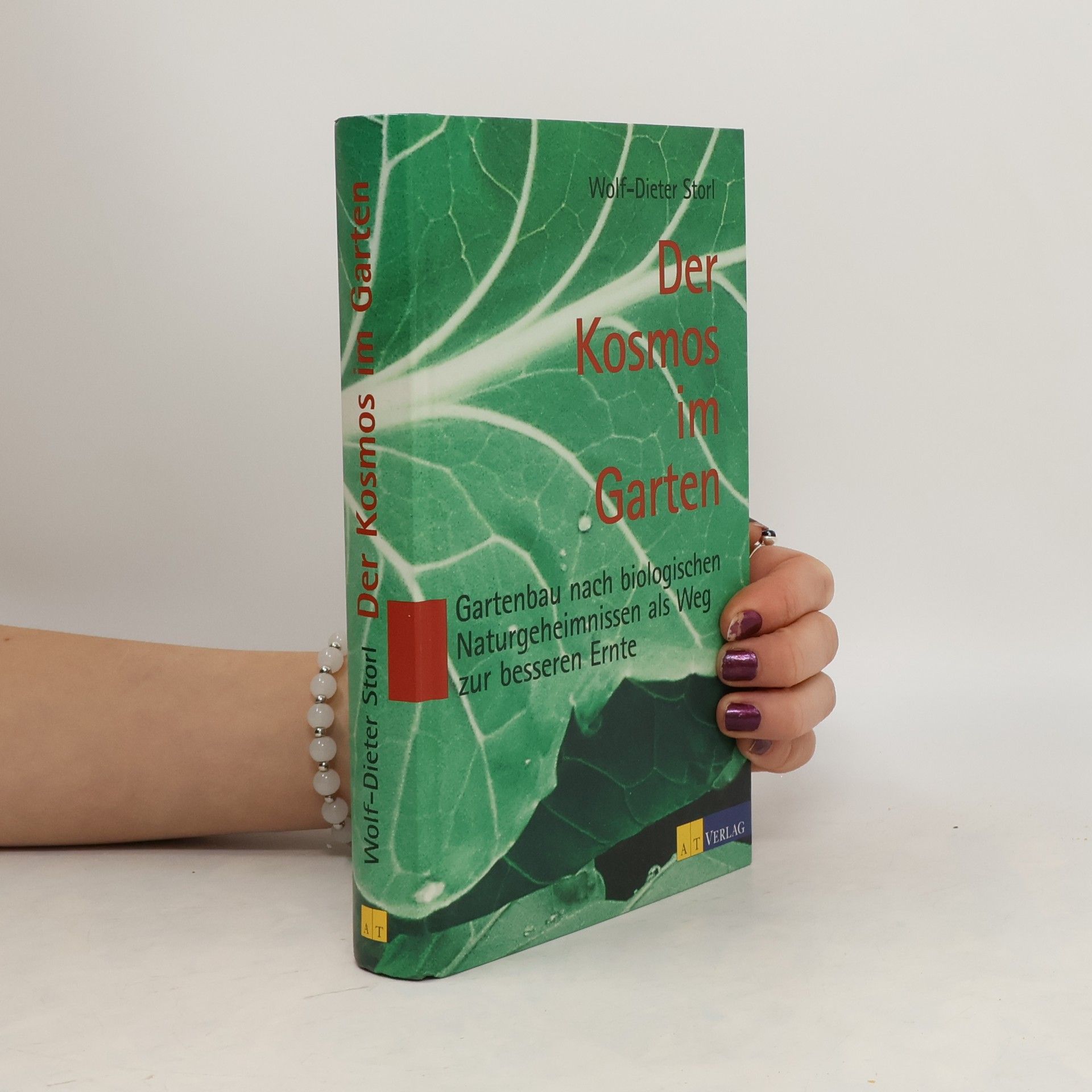Shiva
- 312 páginas
- 11 horas de lectura
An extensive look at all the aspects of multi-natured Shiva.







An extensive look at all the aspects of multi-natured Shiva.
An ethnobotanical look at ancient heart beliefs, heart-strengthening herbs, and folk remedies for cardiovascular diseases
Rostliny jsou víc než se zdá.Rostliny nejsou jen zdrojem výživy a kyslíku. Jsou to jedinečné osobnosti.Setrvávají v absolutním tichu a svým zeleným tělem příjímají sluneční světlo, zatímco síť jejich kořenů proniká hluboko do země a propojujeje s temnotou, světlem vody a minerálů.
Das Geschäft mit dem Garten blüht. Kaum ein Rasenfleck, der von chemischen Düngemitteln und Pestiziden verschont bleibt. Die Wirkung von so viel 'Pflanzenschutz' zeigt sich an kümmerlichen, artenarmen Gärten, an kahl- und kurzgeschnittenen Sträuchern. Der Autor eröffnet dem Leser eine völlig neue Sicht, die das gesamte Wissen der Menschheit über die Naturgeheimnisse vereint, von den Erkenntnissen der Rosenkreuzer, der Alchimisten und Neuplatoniker über Erfahrungen der Indianer und Chinesen bis zu den alten, ewig gültigen Erkenntnissen des Paracelsus und Agrippa von Nettesheim. Das Buch ist eine umfassende, ganzheitliche Natur- und Gartenkunde, die planetare Einflüsse genauso beachtet wie Bodenbakterien und Düngersubstanzen. Anschaulich illustriert erklärt es die grossen Zusammenhänge und bietet zugleich praktische Hilfe, Tipps und Ratschläge aus der biodynamischen Gartenpraxis für alle Arbeiten rund ums Jahr.
Sich der Magie der Pflanzen öffnen Für Wolf-Dieter Storl sind Pflanzen Persönlichkeiten mit eigenem Wesen, die zu uns sprechen, uns Inspiration und Träume schenken. Ob der Knochenheiler Beinwell, der Lebensmut spendende Engelwurz oder die gefährliche Tollkirsche: Mit jeder Pflanze ist der Autor durch besondere Geschichten und Erlebnisse verbunden. Seine berührenden Erzählungen lassen uns die Natur mit anderen Augen sehen, ihre heilbringenden Kräfte erfahren und ihre mystische Seele erleben.
Kräuterkundige wissen, dass selbst die einfachsten Kräuter ihren Wert haben und dass bereits eine Handvoll davon genügt, um sämtliche Leiden zu heilen. Wolf-Dieter Storl nutzt gewöhnliche Wildkräuter: Brennnessel, Beifuß, Gundermann, Geißfuß, Wegerich, Schachtelhalm, Gänseblümchen, Vogelmiere und Löwenzahn. Er beschreibt ihre Eigenschaften und Heilkräfte, ihre Bedeutung in der Volksmedizin, und ihre Rolle in Sage, Märchen und Aberglaube. Neun Heilpflanzen, die vor der Haustür wachsen und sofort verfügbar sind.
Dieses Buch eröffnet einen erstaunlichen Zugang zu einem faszinierenden Bereich unserer Kultur- und Medizingeschichte: zur Heilkunst der Hexen, der verbotenen, geächteten, staatlich und kirchlich unterdrückten „alternativen“ Medizin. Hexenmedizin ist wilde Medizin, sie ist unkontrollierbar und entzieht sich der herrschenden Ordnung. Sie macht Angst, denn sie entscheidet über Leben und Tod. Hexenmedizin ist Kult - schamanischer Heilkult um heilige, das heisst wirkungsvolle Pflanzen. Sie macht mehr als nur gesund: sie bringt Lust und Erkenntnis, Rausch und mythische Einsicht. Die Autoren nehmen uns auf eine Erkundungsreise mit, die zum Ursprung der Heilkunst, durch die antike Mythologie zur kirchenamtlich bestätigten Heilerin der Menschheit und von dort weiter zur Verkörperung der Sinnlichkeit und schliesslich zur Giftmischerin und Heilerin führt. Das Buch öffnet die Tür zum verdrängten, unterdrückten Wissen der Hexenmedizin und zeigt Wege, wie die heiligen Pflanzen unserer Ahnen wieder genutzt werden können.
"Strom bez kořenů nemůže žít. Člověk také ne." Wofl-Dieter Storl Plná historie a mýtů nabízí tato kniha přehled o šamanských kořenech naší kultury a poskytuje čtenáři kontakt s dávnými cestami, které v nás mohou být živé i dnes. Léčivé rostliny, mýtická zvířata, cesty do jinosvěta - inspirativní exkurze do historie a součastnosti šamanství a poselství pro náš moderní svět: MY JSME PŘÍRODA
Kultovní autor Wolf-Dieter Storl prozrazuje své osobní tipy a triky z úspěšné praxe zahradníka – samozásobitele. Vysvětluje všechny důležité práce a dává je čtenáři k dispozici krok za krokem. Bez ohledu na místní klimatické podmínky, kalendářní měsíc nebo počasí ukazuje Wolf-Dieter Storl prostřednictvím přírodních fenoménů – jako například jabloňových květů – kdy nadchází správný okamžik k výsevu semen, k výsadbě sazenic, k mulčování či sklizni. Doprovázejte samozásobitele na společné úspěšné cestě zahradním rokem. Obsáhlé praktické znalosti potřebné k samozásobení po celý rok – od kultovního autora Wolfa-Dietera Storla!
Mythologische Suche nach der Seele der Vegetation. Der Kulturanthropologe und Ethnobiologe will hier keine gesicherten analytischen Tatbestände oder gar eine (para-)wissenschaftliche Botanik vorlegen, sondern nur den seelenlosen Blickwinkel der Naturwissenschaften um spirituelle Aspekte ergänzen. Ist es der Geist einer Pflanze, der heilt, oder ihre chemische Zusammensetzung, fragt er und nimmt den Leser mit auf einen amüsanten Streifzug durch Mythen und Überlieferungen versunkener Völker sowie bewahrter Traditionen. Storl plaudert über Gärtner, die telepathisch mit Pflanzen verkehren und sie zu erstaunlichem Wachstum animieren. In Zeiten seelischer Verödung durch die industrialisierte Landwirtschaft blickt er auf naturverbundene Völker wie die Indianer und Kelten, die über Rituale mit Devas kommuniziert haben. Er empfiehlt meditative Wege einer Annäherung und nennt Methoden zur Einstimmung (Diät, Bäder, Räucherungen, Kräuter, Rituale). Nachdenklich stimmende, gut lesbare Lektüre. - Ergänzend zu P. Tompkins: "Das geheime Leben der Pflanzen" (BA 5/98). (2) (Freya Rickert)